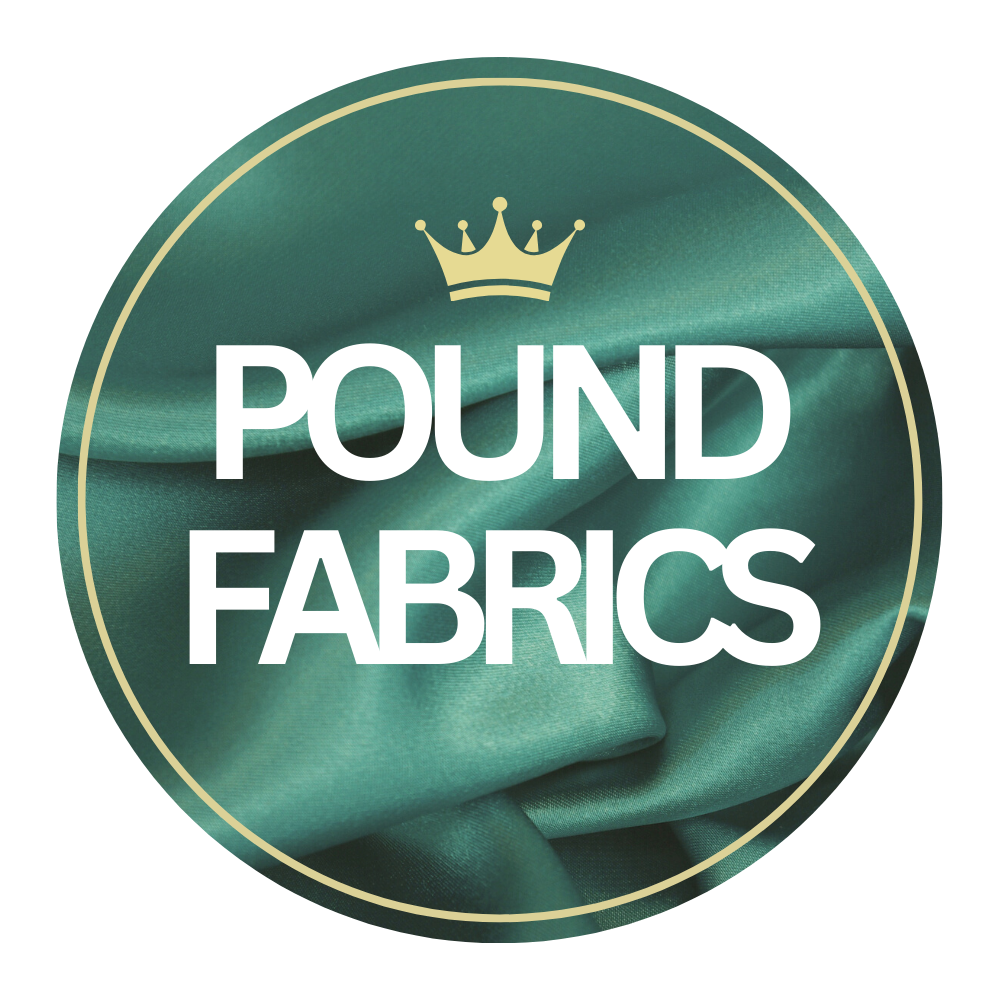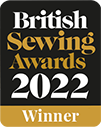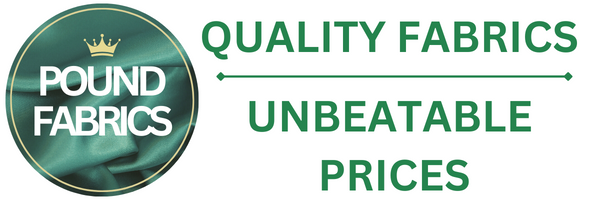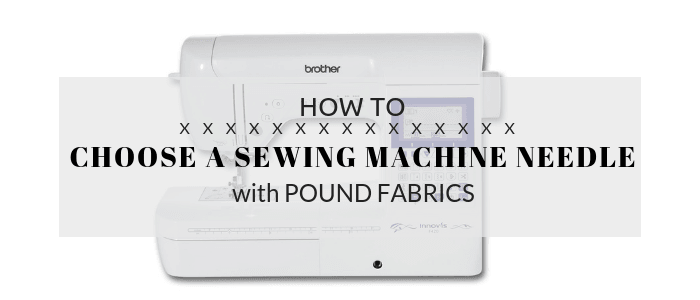
When you first begin to sew, it makes sense to sew all of your projects with the needles provided with your machine. However, as you begin to get more confident and branch out to different fabrics, it is important to consider what type of needle you use. This is because the wrong type of needle can lead to breakages, poor stitch quality and can even damage you or your machine!
This guide is designed to help you see the variety of sewing machine needles available and their uses. You'll be pleased to know that nearly all sewing machine needles are standardised, meaning they work across all machines and brands. The only time the style and fit may differ is on very old machines - most modern machines have a similar needle set up!
Types of sewing machine needles:
Universal Needles-These are the most commonly used type of machine needle. You can sew woven fabrics, synthetic fabrics and even some knit fabrics. For lightweight fabrics, use a finer Universal needle and for heavier weight fabrics, use a larger needle. Combine with a polyester, cotton or silk thread depending on the composition of your fabric.
Ballpoint Needles-These needles have a rounded tip, rather than a fine, sharp tip. The rounded tip pushes any fibres aside, rather than piercing through them, preventing running and laddering. These needles work best with rib knits, interlock knits, cotton knits, fleece, double knit and other knit fabrics. Use with a polyester or a polyester blend thread, depending on the composition of your fabric.
Stretch Needles-These needles have a scarf protrusion which allows an extra bit of room for the hook of your machine to pass by while sewing, preventing skipped stitches that usually occur when sewing stretch fabrics. Use these needles to sew lycra, power net, 2 Way stretch knits, silk jersey, spandex, very elastic synthetic fabrics and even elastic. Combine with a polyester thread.
Quilting Needles-Like Sharps needles, these needles are good at penetrating several layers of fabric and wadding, so are perfect for quilting. They have a reinforced shaft and are fairly short, making for quick, even stitching. For beginners of quilting, a size 7 or 8 quilting needle is recommended, anything bigger would be better for more advanced quilters.
Jean/Denim Needles-These needles are great for denim, and other densely woven fabrics. They have a sharp point, and a strong shaft and shank, important for penetrating thick, heavy fabrics. These needles work best on denim, heavy twill and canvas. Combine with polyester, synthetic blend, cotton wrapped polyester or top-stitching threads, depending on the composition of your fabric.
Leather Needles-These needles are sometimes known as chisel-point needles, due to the shape of the tip of the needle. They are designed to be used only with real leather and suede - don't use them with imitation leather, ultra suede or imitation suede, as the fabric composition is completely different, and they won't work correctly.
Metafil Needles-These needles are designed especially for use with metallic thread and fabric. They are also perfect for use on embroidery projects and work best on woven or knit fabric. They work so well for intricate tasks as they have an extra-large eye, which allows the thread to have more space to move freely, avoiding splitting or shredding.
Sharps Needles-These needles are fantastic to use when quilting. This is because they are very fine and sharp and can easily penetrate several layers of fabric or wadding. These needles are also good for densely woven fabrics, silk and microfibre. As well as being thin and sharp, these needles have a stronger shaft. and a round threading eye for extra strength when sewing. Sharps needles create fantastic buttonholes.
Top-Stitching Needles-These needles have an extra sharp point, to pierce through almost any fabric. Even though they have a fine point, in comparison they have a relatively large eye, to allow thick top-stitching thread to be used.
Twin/Triple Needles-These are specialist needles used for pin-tucking and other decorative stitches. They need to be used on your machine at a reduced speed, as they can create quite complicated stitch styles. These types of needles are not compatible with all machines, so double check if your machine can use them.
Wing Needles-These needles are also used for special, or decorative stitches. They produce holes in fabric to reproduce drawn thread work, a technique traditionally created by hand. Combine with cotton or natural threads for the best results, as these threads create tighter, neater work.
Embroidery Needles-These needles are similar to Metafil needles, but have a wider eye, and a scarf to prevent missed stitches and restrict fabric movement, while allowing free thread movement. They work best on fabrics like viscose/rayon, polyester and cotton.
What do needle sizes actually mean?
Needle sizes can look a little confusing - why are there two different numbers? These two numbers are simply, the European needle size and the American needle size! The European sizes are written first, and range from 60-110, thin to thick. The American sizes are written after the forward slash, or in brackets, and range from 8-18, thin to thick. Usually, when you buy a new machine, it will come with a needle size 80/12, as this is the standard dressmaking size.
How often should I change my needle?
You should aim to change your needle every 5-10 hours of sewing, or if you find it hard to keep track, every 2 projects. Of course, if your needle becomes bent, broken or dull, change it as soon as possible to reduce damage to you, your machine or your project!
Quick reference needle size chart
|
NEEDLE TYPE |
NEEDLE SIZE |
FABRIC/PROJECT TYPE |
|
Universal Needles |
70/10 |
Voile/Sheer/Silk |
|
80/12 |
Shirting/Poplin/Viscose/Light Wool |
|
|
90/14 |
Medium-heavyweight Calico/Linen |
|
|
100/16 |
Heavy fabric/Bag making/Upholstery |
|
|
110/18 |
Extra heavyweight fabric/Upholstery |
|
|
Sharps Needles |
70/10 |
Voile/Microfibre |
|
80/12 |
Shirting/Microfibre/Patchwork |
|
|
90/14 |
Top-Stitching |
|
|
Ballpoint Needles |
70/10 |
Lightweight Knit/Tricot |
|
80/12 |
Interlock Knit |
|
|
90/14 |
Medium to heavyweight Knit/Double Knit |
|
|
Stretch Needles |
75/11 |
Light Lycra/Elastic |
|
90/14 |
Elastic/Heavyweight Lycra/Elasticated fabric |
|
|
Jean/Denim Needles |
90/14 |
Denim/Woven |
|
100/16 |
Heavyweight Denim/Vinyl/Furnishings |
|
|
Leather Needles |
90/14 |
Leather/Suede |
|
100/16 |
Leather/Suede |
|
|
Metafil Needles |
80/12 |
Decorative sewing |
|
Quilting Needles |
80/12 |
Cotton/Wool/Polyester/Wadding/Quilting |
|
Embroidery Needles |
75/11 |
Decorative sewing on lightweight fabric |
|
90/14 |
Decorative sewing on medium to heavyweight fabric |
|
|
Twin Needles |
Various Sizes |
Decorative sewing on most fabrics |
This is just a quick rundown of some of the needles available and their uses. We recommend experimenting for the best fabric, thread and need combinations, as all fabrics and projects will be different. Also, don’t forget to keep a stock of needles that you will be sewing with the most – they always seem to break or dull at the most inconvenient times!
To see our full range of fabrics, please click here.
Make sure to tag us @poundfabrics and show us your creations on Instagram, Facebook and Twitter!
Copyright © 2019 Pound Fabrics. All Rights Reserved











NurulAmin
August 27, 2021
Nice example thru Learn.